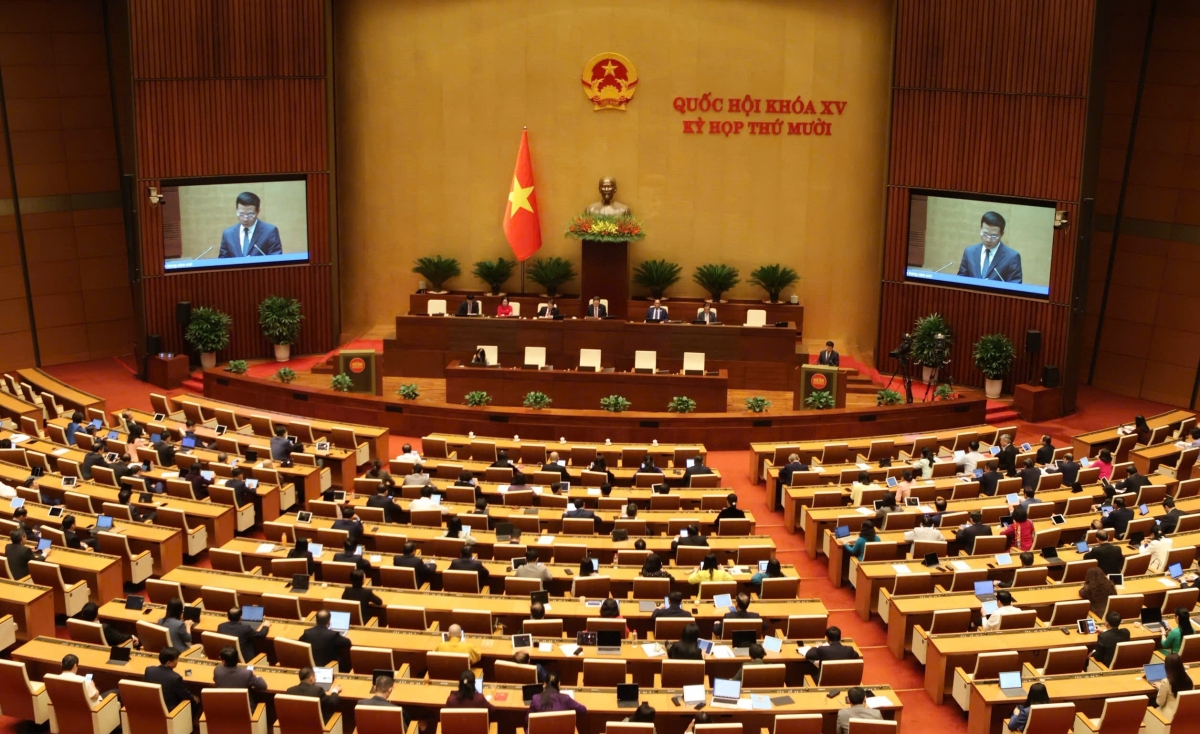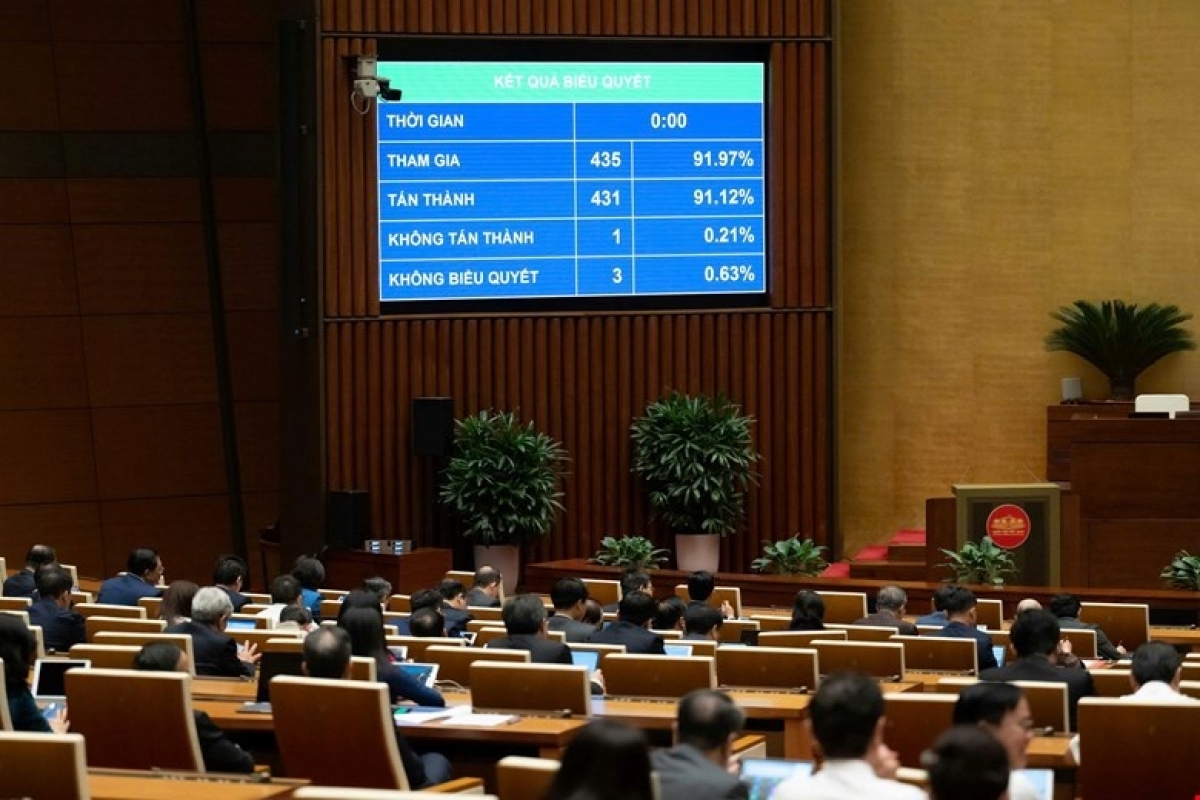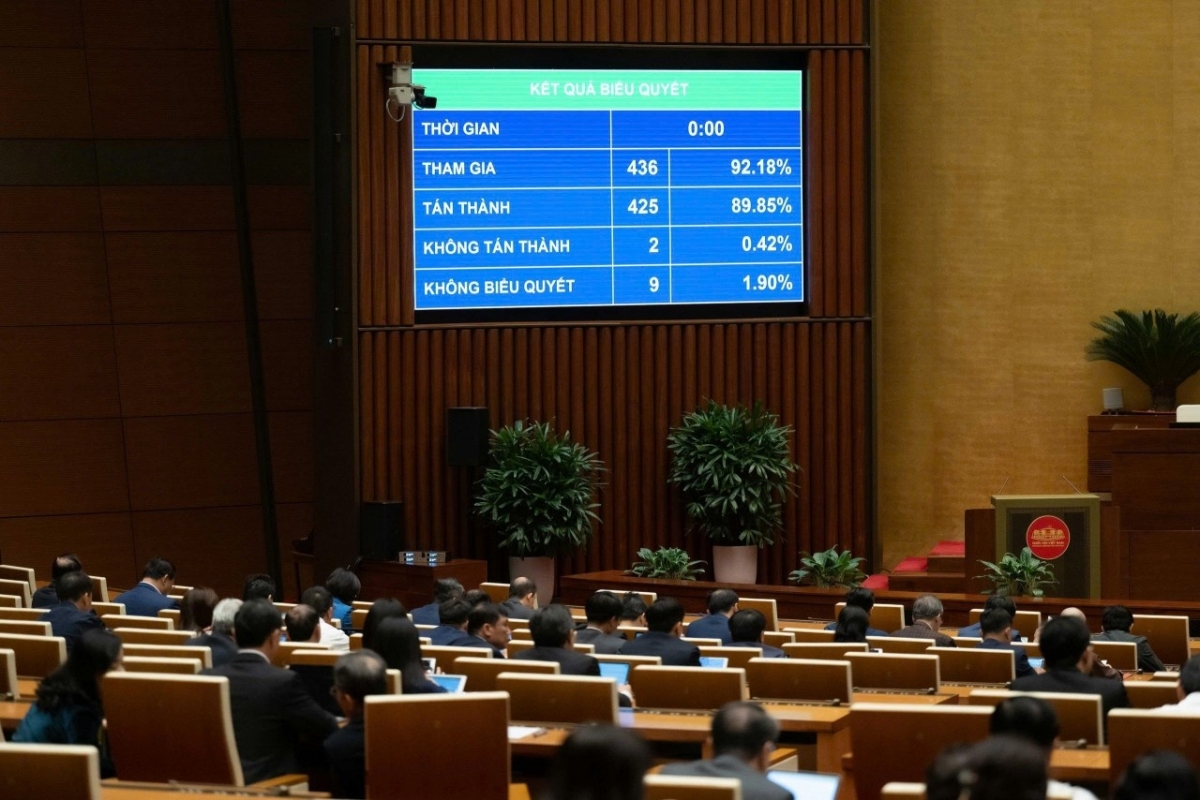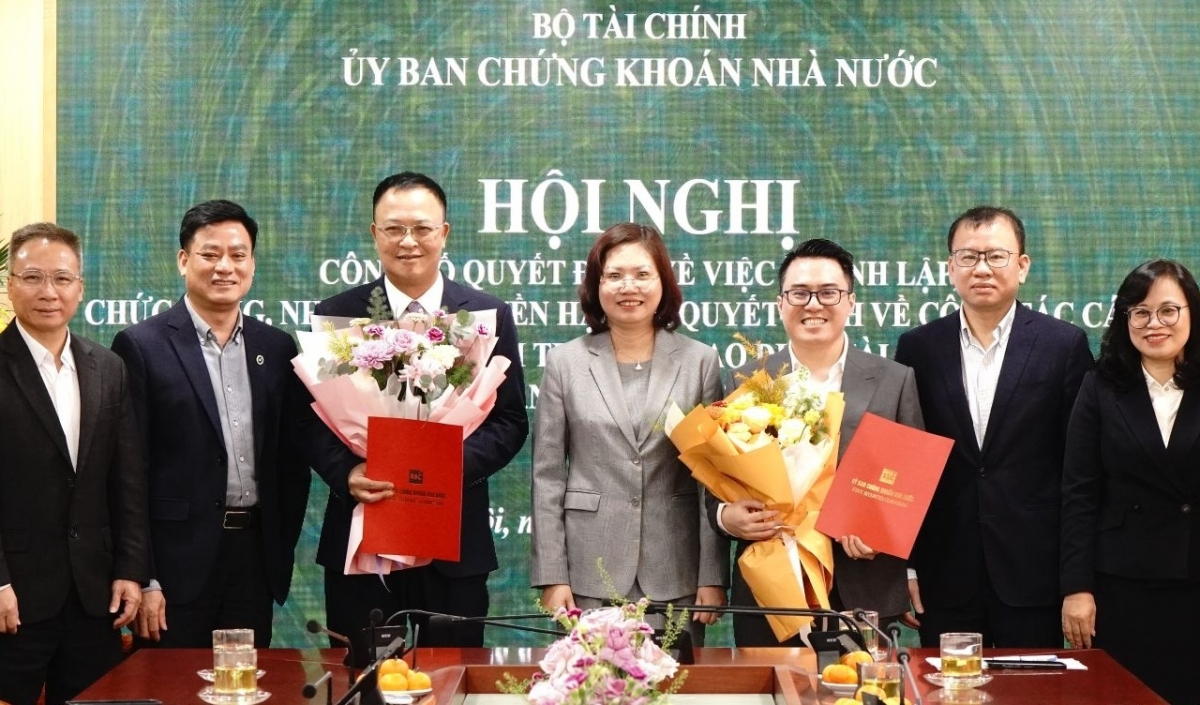INTERNATIONAL INVESTMENT
AND PORTAL
The government is implementing the first steps of the Economic Restructuring Plan for 2021-2025, setting out the requirements for a more effective and substantive implementation based on strengthening and maintaining macroeconomic stability, in line with the vital tasks according to the resolution of the 13th Party Congress.
 ERP puts business advances at centre, (Photo: VNA)
ERP puts business advances at centre, (Photo: VNA)
The Economic Restructuring Plan (ERP) is a continuation and concretisation associated with specific conditions of the next period. In the previous five years, the implementation achieved many important results, completing targets and increasing growth and labour productivity.
As an advisory body to the government and the Ministry of Planning and Investment’s Central Institute for Economic Management (CIEM) emphasised that Vietnam needs to develop an economy and competitiveness based on science, technology, and innovation.
CIEM director Tran Thi Hong Minh said, “This is a completely new point compared to previous documents, contributing to the recovery and development of the economy in the next period.”
As the pandemic continues to depress the global economy and disrupt supply chains, Vietnam’s business community has been particularly interested in the government’s current approach.
Vu Tien Loc, former chairman of the Vietnam Chamber of Commerce and Industry, said, “The operation of some markets remains limited and underdeveloped, which could affect the recovery of production and business.”
Loc stated that the restructuring in the 2016-2021 period remained limited, especially since the ability to mobilise and absorb capital was not high.
“The connection between supply and demand in the labour market and the quality of human resources has not yet met the requirements. The market for land use rights, especially agricultural land, is still inadequate. The science and technology market develops slowly, not representing a driving force to improve productivity and competitiveness,” Loc said.
In the new ERP for the 2021-2025 period, for the first time, the task of corporate development is placed centrally, with the requirement to promote the connection between businesses of all sectors and foster innovation.
In that direction, the proportion of the private sector’s contribution to GDP during this period was raised to about 55 per cent. The role of foreign direct investment is also promoted through investment attraction mechanisms that also encourage the transfer of advanced technologies and modern governance.
The ERP sets the target, that by 2025, the country will have 1.5 million enterprises, of which there are up to 70,000 medium- and large-sized ones.
“This goal is a huge challenge, as every year there must be about 180,000 businesses added,” Loc commented.
Last year, the whole country had about 116,800 newly-established enterprises, but 119.8 businesses suspended operations or left the market.
Restructuring the economy now can still create new achievements, according to many domestic economists, thanks to breakthrough solutions of the government and the country’s long-term development potential.
Part of these solutions will be to launch short-term monetary and fiscal packages, promulgate specific mechanisms for several localities, and pilot the application of shortened administrative procedures to promote public investment activities.
Dr. Nguyen Dinh Cung, a member of the Prime Minister’s Advisory Group for the previous and upcoming five years, commented, “The ERP to 2025 has five ongoing key tasks in most areas of the economy, including restructuring public investment, state budget, finance and banking, and strengthening regional links.”
Cung also explained, “Institutional reforms should be the focus of economic restructuring. New institutional reforms must continue to expand the freedom to do business of people and companies by removing all barriers, not only by allowing them to choose what they do but also how they do it.”
Vietnam has set the target to become a developing country with modern industry and high middle income by 2030 and, by 2045, to become a developed country with high income.
“The internal strength of the Vietnamese economy still has great potential for development, with the current foundation, the economy can grow up to 10 per cent a year. The important issue is to improve the efficiency use of the country’s resources,” said Cung.
“The total social investment accounts for 34 per cent of budget expenditure. If the capital efficiency index is lowered, GDP can increase to over 8 per cent per year. Resources are waiting to be restructured such as inefficient state-owned enterprises, abandoned land, and private enterprises. If investment efficiency is increased, Vietnam can have 10 years of high-speed growth,” he added.
Phan Duc Hieu - Standing member Economic Committee of the National Assembly
A goal of the ERP is to improve the business environment for its competitiveness and development. Institutional reforms will facilitate market entry for businesses but also lead to a fiercer environment, which could become a great challenge for enterprises with limited competitiveness.
If enterprises do not make greater efforts to overcome their internal limitations in terms of corporate governance, business skills, and social responsibility, they will certainly not have a place in the market. A partnership between the government and businesses can overcome these challenges.
Dr. Le Xuan Sang - Deputy director Institute of Economics Academy of Social Sciences
The previous ERP did not meet the desired goals. The progress of equitisation and divestment of state capital in state-owned enterprises (SOEs) was generally slow, and the equitisation progress also remained quite low.
Some projects had been put into operation with products and employees, but have accumulated relatively large losses, causing some of them to remain unfinished or cease operations. There are still inadequacies in the governance of SOEs, with directors and managers not fully dedicated or creative enough for the company’s development. Requirements for managers and leaders of SOEs have also not attracted and encouraged talented people.
Assoc. Prof. Dr. Vu Sy Cuong Academy of Finance Ministry of Finance
Vietnam needs to consider fiscal policy packages to support people and businesses. At the same time, businesses in a number of fields need to be encouraged to continue investing in their business.
In the medium term, the interest rate may increase when the capital demand for the economy increases. At the same time, the country’s fiscal policy needs to review decentralised spending between the central and local authorities.
Vietnam will face difficulties in implementing inter-provincial socioeconomic development projects without a financial and budgetary mechanism.
The reforms of the last five years were geared towards building a single platform as the focal point for receiving business registration information. Decree No.122/2020/ND-CP stipulates that such an agency should receive dossiers and handle the registration procedures for enterprise establishments.
 By Dr. Dinh Tuan Minh - Research director, Massei
By Dr. Dinh Tuan Minh - Research director, Massei
Moreover, when performing these tasks, IT should be applied as a more effective way for individuals to start a business. But in reality, businesses still have to use many different platforms when carrying out some procedures, such as with tax authorities and insurance for employees.
State agencies have to manage many different platforms, located at many different management agencies, which makes it difficult to synchronise information. Businesses thus need time to learn how to declare the same type of information multiple times and interact with different agencies.
The Ministry of Planning and Investment is currently managing two separate domain names with the same name, the National Business Registration Portal. One portal specialises in providing all kinds of information on business registration; the other specialises in providing online business registration services.
Using two separate domains just to serve the current procedure is wasteful and unnecessary. Elsewhere, Singapore’s Bizfile+ is the only platform that provides services to register businesses’ information with state agencies.
On Bizfile+, there is a clear classification of business types, accompanied by clear instructions. Information on legal bases is posted directly on the website of the governing body of the platform.
The platform not only provides registration services but also many other related services such as VAT registration, insurance registration, some audit services, and so on.
After businesses fill in the information and submit it, the system will automatically forward the information to specialised government agencies. The results will then be recorded by Bizfile+ and saved on the system. When procedures related to enterprise information are executed on the same declarative platform and such a database, synchronisation will be faster and easier.
Challenges to Vietnam’s reform come from many aspects. However, the question is how to reform the procedures while ensuring uniformity in the legal system, and how to improve the quality of IT applications in handling business registrations.
Since the Law on Enterprises 2014 took effect, information on business lines has been removed from the certificates of business registration, helping them avoid re-registering certificates when changing industries. However, when registering their business online or in person, the main and minor business lines are still mandatory items for registrants. After that, if an enterprise changes its business line, the enterprise must again carry out the notification procedures with the agency.
As noted by some representatives in the industry, this is one of the parts that confuse businesses and often takes the most time to adjust. Therefore, if it can be cut or simplified and would render business registration procedures faster and easier.
However, with the current legal framework, it is not feasible to remove the business line declaration. The reason is that businesses have to carry out other procedures related to tax or customs authorities. These agencies require the correct declaration of the registered business line for their profession.
Experiences from countries that have successfully reformed have shown that, regardless of administrative boundaries, the solution would create a market-type competitive pressure between business registration offices in different cities and provinces.
If implemented, this could help reduce the load on local offices with a large number of newly-established enterprises. In addition, if the service quality of a city or a province is good, it will attract many businesses to register for the establishment and create competition among such offices, ultimately improving the service quality.
In principle, this solution can be implemented uniformly across the country. Where an enterprise registers to settle the dossier does not affect where the enterprise actually registers its business, and thus this also does not affect the tax payments of the enterprise in the locality where the enterprise wants to locate its headquarters.
However, such a proposal is unlikely to become a reality in practice under the current conditions. The staff of the offices are all state employees and are paid according to the seniority coefficient, not the number of files that can be resolved.
Therefore, registration offices in provinces with few records will not be interested in processing applications of enterprises not registered in their province. In the coming economic restructuring process, if the salary and bonus mechanisms for civil servants cannot be changed based on achievements, this solution will not be possible.
What influences the implementation of the 5-year plan for economic restructuring?
 Prof. Dr. Nguyen Quang Thai, chairman of the Vietnam Economic Association
Prof. Dr. Nguyen Quang Thai, chairman of the Vietnam Economic Association
The plan is influenced by many factors, both from the outside and the inside. However, the latter is the more important part. The positive aspects related to political and macroeconomic stability have reassured foreign investors and helped them to better interact with domestic enterprises and develop together.
International and regional integration continues to be a major direction. However, since the Russia-Ukraine conflict occurred, the situation has become more complicated, with supply chains disrupted and the occurrence of an unprecedented increase in commodity prices.
Meanwhile, challenges related to climate change continue to negatively impact the implementation of Vietnam’s commitments to greenhouse gas reduction and efforts to protect the planet.
However, the biggest concern at present is that the modernisation of the institutional system has not kept pace with the requirements of the new era. For many businesses, government institutions remain bottlenecks that need to be improved, although the investment environment has generally improved. The weaknesses of the management apparatus, especially at intermediate and grassroots levels, are causing difficulties for businesses and people.
Meanwhile, the uneven development of industries, regions, and social classes has rendered economic links insufficient. Resources have not been fully evaluated and allocated, and skilled workers merely make up a quarter of the labour force, hindering the increase of productivity for the whole society and the ability to absorb new technologies.
The macroeconomic stability continues to face challenges, especially with the recent shake of the stock market, the scandals related to corporate bonds, and the ongoing state budget deficit. While all of this is happening, savings remain low, and the efficiency of public investment disbursement is not high.
Could some issues come from overlap with previously approved strategies and plans?
No, there are absolutely no duplicates as the restructuring plan is a succession, with updates and adjustments. However, the pandemic response and national governance should be considered important factors throughout the economic restructuring process in the next five years.
It’s also crucial that advanced methods related to national governance must be adapted to each stage, especially during recovery and development, in order to achieve strength and prosperity in the next 30 years.
Vietnam is now reopening its economy again, but it is still necessary to prepare new scenarios and flexible policies that take into account the impact of new COVID-19 variations that may affect the whole society and economy.
In the process of economic restructuring, what principles should be applied in resource allocation and usage?
Allocating and using resources efficiently is the function of a true market economy. Therefore, during the restructuring process, the allocation and usage of resources must be carried out institutionally and in a modern way.
Land resources are overlooked at the moment, as the equitisation process of state-owned enterprises (SOEs) removes the location factor, continuing to focus on counting the number of factories. The equitisation of the Vietnam Film Studio in Hanoi is an example.
Besides this, other resources could also be missed if the restructuring process still calculates the asset prices of SOEs based on the books and does not take into account cars, cryptocurrencies, and bonds, among others. In addition, human resources are also neglected.
Market principles must also be maintained throughout the resource allocation, with regular monitoring and ad hoc audits. Rigidity in the implementation of stagnating plans, as well as administrative orders, needs to be applied thoroughly to reach good results in the allocation and use of resources. For example, when it comes to the land of SOEs in the Mekong Delta province of Soc Trang that have good soil, after equitisation, it would be possible to consolidate and exchange plots to make larger sample fields.
In contrast, with infertile and arid soil in the northern provinces of Son La or Bac Giang, it would be possible to develop high-yielding corn and soybean areas, and not necessarily special fruits.
How urgent is it to make adjustments and guarantee a smooth restructuring?
Vietnam’s economic potential has been eroded after the pandemic, but it is still relatively diverse thanks to increased connectivity. The problem now is that many factors need to be calculated more efficiently.
Vietnam’s average growth rate of 6 per cent does not compare to many countries in the region, such as South Korea, whose economic growth was higher than 7 per cent for many years. Without quickening the growth speed, Vietnam will not be able to catch up. However, growth must be accompanied by quality and sustainability in the economy, environment, and society. This perspective requires comprehensiveness, both in economic restructuring and institutional reforms.
By Van Nguyen



















